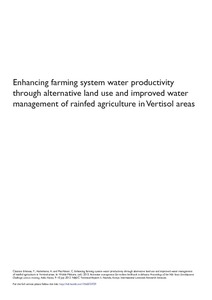Resource information
Waterlogged Vertisols are amongst the high potential soils where management interventions could result in positive impacts. This study utilized soil, climate and crop and livestock productivity data and models to demonstrate intensification strategies which increase crop–livestock system productivity and to understand the effects of alternative land use and water management options on water productivity in the Vertisols areas. The areas have been classified into three slope classes including areas where artificial drainage is not feasible, where Broad Bed and Furrows (BBF) can be used to drain the excess water and naturally drained areas, represented by areas with 0–2%, 2–5% and over 5% slope steepness, respectively. Early planting of wheat (Triticum spp) using BBF on drainable areas and rice (Oryza sativa) or grasspea (Lathyrus sativus) on the flat areas were compared with the traditional practices. Yield and biomass data were obtained from research stations in the area whilst the effective rainfall and crop water requirement were estimated using CROPWAT Model. The feed value of the native grass and crop straw was estimated based on previous works. With respect to effective rainfall, the water productivity increase due to BBF over the control ranged from 5 to 200%, with an average increase of 57%. Despite higher water consumption of the rice, feeding its residues to livestock enhanced the overall economic water productivity of the system over the natural grazing or grasspea cultivation. Consequently, use of BBF enables growing high value or food crops of choice that may be sensitive to waterlogging whilst tolerant crops can be grown on flat lands allowing utilization of the full growing period. Coupled with livestock integration into the system, the alternatives can enhance food production and resource use efficiency from these ‘marginal’ areas.



